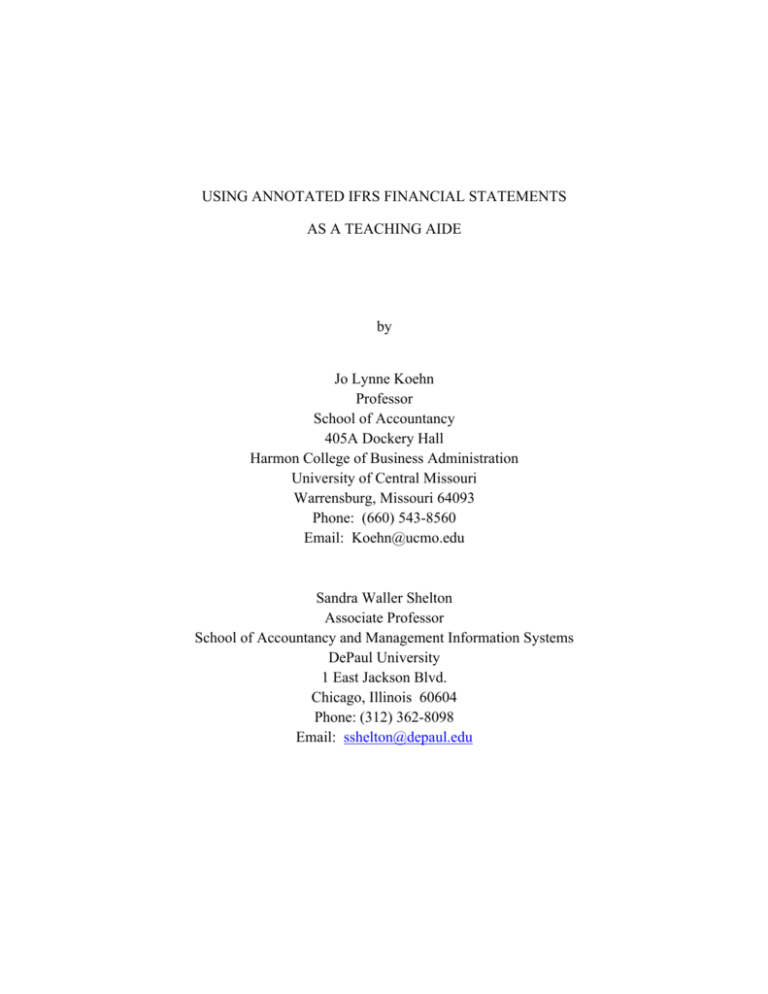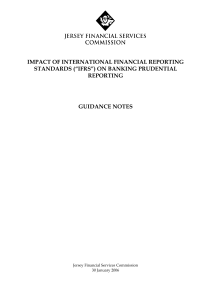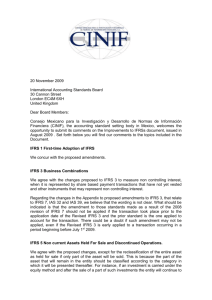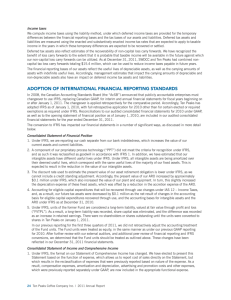USING ANNOTATED IFRS FINANCIAL STATEMENTS AS A
advertisement

USING ANNOTATED IFRS FINANCIAL STATEMENTS AS A TEACHING AIDE by Jo Lynne Koehn Professor School of Accountancy 405A Dockery Hall Harmon College of Business Administration University of Central Missouri Warrensburg, Missouri 64093 Phone: (660) 543-8560 Email: Koehn@ucmo.edu Sandra Waller Shelton Associate Professor School of Accountancy and Management Information Systems DePaul University 1 East Jackson Blvd. Chicago, Illinois 60604 Phone: (312) 362-8098 Email: sshelton@depaul.edu USING ANNOTATED IFRS FINANCIAL STATEMENTS AS A TEACHING AIDE INTRODUCTION In July 2009 PriceWaterhouseCoopers (PWC) sent an email communication to collegiate accounting educators regarding job candidate preparedness relative to International Financial Reporting Standards (IFRS). In this email PWC expressed an expectation that as of Fall 2009 sophomore students should be developing a "pre-awareness" of IFRS and that interviewing juniors and above should have a "full awareness" of IFRS. "Pre-awareness", per PWC, consists of the abilities to define what IFRS stands for; articulate the general uses of US GAAP and IFRS; and recognize the important future role for IFRS. In contrast, PWC sees "full awareness", which it expects of juniors and beyond, as the 3 pre-awareness tasks outlined above plus a knowledge of the sources of US GAAP and IFRS; ability to describe examples of IFRS financial statements; ability to identify an example of a difference between US GAAP and IFRS, and, finally, the ability to explain the current status of IFRS and the likely timetable for its adoption. The communication from PWC clearly communicates the industry's expectation that students be currently knowledgeable about IFRS. The timetable expressed (Fall 2009) may be challenging for some educators to meet as a recent survey indicates that some accounting programs plan to defer IFRS incorporation into the curriculum until 2010 and beyond with other respondents expressing uncertainty as to when their curriculums would significantly incorporate IFRS (Munter and Reckers 2009). The availability of IFRS teaching resources is also challenging as the 3 year time cycle for textbook publication may not present the optimal timetable for IFRS incorporation. The latest editions of textbooks are beginning to integrate IFRS discussions but many professors, given the scarcity of IFRS current texts, have been relying on information from accounting firms or have developed their own notes (Kroll 2009). This article may assist educators that are compiling teaching resources in the area of IFRS financial statements. A key element of "full awareness", as expressed by PWC, is the ability of students to describe examples of IFRS financial statements. This teaching note provides instructional content and an example of a set of annotated international financial 2 statements that offer a presentation of a set of financial statements prepared under IFRS. The statements presented are the 2008 statements of GlaxoSmithKline (GSK)1, GSK is a United Kingdom-based based pharmaceutical, biological, and healthcare company that is the world's second largest pharmaceutical company. The call-out boxes, that add emphasis to certain features of the financial statements, are a tool available in Adobe Acrobat Professional software. IFRS: INCOME STATEMENT The following bullets provide guidance on certain presentation elements as exhibited in the GSK income statement. The presentation points cross-reference to the call-out boxes on the income statement. Table 1 cross references bullet content to IAS guidance paragraphs. 1A: IFRS require a comparative presentation of the current with the prior year. 2A: No particular format is prescribed but GSK's statement resembles a multiple-step format. IFRS does require, however, a fair presentation which faithfully represents the effects of transactions. 3A: The heading should include the name of the statement. 4A: The heading also informs whether the statements are for a singular enterprise or for a consolidated group. 5A: The sub-heading shows the date or period being reported and this is often given with the day of the month before the name of the month. 6A: The level of truncation (thousands, millions, etc.) and the reporting currency must also be shown. 7A: IFRS sometimes uses account titles not used under US GAAP. Note here that revenue is referred to as "turnover". 8A: IFRS allows expenses be presented according to nature or function. Here we see evidence of a grouping by function into operating expenses and several expenses related to financing. 9A: IFRS states that entities shall cross-reference financial statement items to relevant footnote explanations of the items. 10A: IFRS allows the presentation of basic and fully diluted EPS from continuing operations and from net profit and loss. 11A: Net income or net earnings is referred to as "Profit". IFRS allow some latitude in the labeling of totals as long as the meaning is clear. 12A: IFRS does not allow separate presentation of extraordinary items. Also, the IFRS does not regard gains and losses as separate elements of the income statement. 1 The 2008 GSK financial statements are extracted from GSK's 2008 annual report and reprinted here with the written permission of GSK. 3 IFRS: BALANCE SHEET (STATEMENT OF FINANICAL POSITION) 1B: IAS 1 states a preference for the title "statement of financial position" over balance sheet. The International Accounting Standards Board [IASB] feels this titling most fully reflects the function of this statement. However, the Board allows reporting entities to use titles other than those used in the IAS 1 standard. 2B: All statements must present a minimum of two years of comparative information. 3B: Entities shall present current and non-current assets, and current and non-current liabilities, as separate classifications in the statement of financial position. 4B: When a presentation based on liquidity would provide more reliable and relevant information, an entity should present all assets and liabilities in order of liquidity. 5B: IFRS does not prescribe the order or format of the statement of financial position. 6B: IFRS specifically prohibits "deferred tax assets/liabilities" from being classified as current. 7B: Since format is not prescribed in IFRS the statement of financial position may be presented in a variety of formats. Here we see assets - liabilities = equity. Some entities using IFRS may choose assets = liabilities + equity. Another possible format is fixed assets + current assets short-term payables = long-term debt + equity. 8B: The balancing total for the statement is net assets equaling total equity rather than total assets equaling total liabilities plus equity. 9B: Alternative terminology often appears in the equity section with reference to the "additional paid-in capital account". Here this account label is "share premium account". Alternate titles include share issue premium or capital reserves. IFRS: STATEMENT OF CASH FLOWS 1C: The statement of cash flows is a required statement that is considered an integral part of the financial statements of each period and helps comprise what IFRS refers to as a complete set of financial statements. 2C: The statement of cash flows reports cash flows during period classified by operating, investing, and financing activities. 3C(A) & 3C(B): Firms must show the details of cash generated from operations either in the body of the statement in the operations section or as GSK has done with these details provided in a separate schedule in the notes. 4C: Cash flows related to taxation must be separately disclosed and are usually identified in the cash flow section unless an entity can specifically identify a tax cash flow with an underlying financing or investing activity. 4 5C: IFRS allows either the direct method or indirect method for reporting cash flows from operations. Entities reporting under IFRS are encouraged to use the direct method. 6C: Cash flows from interest and dividends received and paid are to be each disclosed separately. Entities must consistently classify these items period to period as either operating, investing, or financing activities. Interest paid and interest and dividends received, if helping to determine profit or loss may be classified as operating activities. Alternatively, entities may choose to classify these items as investing or financing flows because they are costs related to obtaining financing or represent returns on investment. 7C: IFRS excludes non-cash investing and financing activities from the statement of cash flows. Entities disclose the relevant information related to these transactions elsewhere in the financial statements. 8C: IFRS requires a component presentation of cash and cash equivalents with a reconciliation of the amounts in the statement of cash flows with the equivalent item presented in the balance sheet [statement of financial position]. BACKGROUND: STATEMENT OF CHANGES IN EQUITY IFRS requires a statement of changes in equity showing [adapted from Niswander and Conover 2009]: 1. Profit or loss from the period. 2. Items of income or expense recognized directly in equity. 3. The sum of 1) and 2) must be allocated to amounts attributable to parent and minority interests. 4. For each component of equity, the cumulative effects of retrospective application or retrospective restatement in accordance with IAS 8. Further required presentations- either as part of the statement of equity or in notes include: A. Distributions to/from owners of the company. B. For each component of equity (retained earnings, capital, additional paid in capital, reserve, etc.) a reconciliation of balances between the beginning and end of the period. Some entities applying IFRS will choose to present a statement of changes in equity similar to the US GAAP - statement of stockholders' equity which has columns for each equity account with presentation of the items affecting the balance of each account from beginning to end of period. Alternatively, IFRS allows a choice to present a statement of recognized income and expense. This alternative will show profit and loss, items recognized directly in equity, and transactions with owners. This latter treatment will not show reconciliation of all equity account beginning and ending balances which a company could choose to disclose in the notes. GSK chooses to present a statement of recognized income and expense. 5 IFRS: STATEMENT OF RECOGNIZED INCOME AND EXPENSE 1D: GSK chooses to present the alternative type statement including the required elements 1-4 above. 2D: However presented, the statement of equity must show the profit or loss for the period. 3D: Each item of comprehensive income (those directly effecting equity) must be shown. 4D: The total recognized income and expense for the year is split into amounts attributable to parent and non-controlling (or minority) interests. CONCLUSION This paper presents teaching notes and an annotated set of original financial statements prepared by GSK using IFRS. The annotated statements represent a teaching aide that instructors may easily share with students via a document camera in the classroom, screen projection, posting on Blackboard as a file, or via a handout. By exposing students to this annotated set of actual IFRS financial statements students can start to achieve the "fullawareness" level of comprehension expressly required by the profession. 6 REFERENCES International Accounting Standard 1: Presentation of Financial Statements, effective January 1, 2009 International Accounting Standard 7: Statement of Cash Flows, effective January 1, 1994. International Accounting Standard 8: Accounting Policies, Changes in Accounting Estimates, and Errors, effective January 1, 2005. TABLE 1 Cross referencing of annotations to IAS paragraphs/sections of related guidance 1A 38 [IAS 1] 2A 15,17 [IAS 1] 3A 49, 52 ,57 [IAS 1] 4A 51(a)(b) [IAS1] 5A 51(c) [IAS1] 6A 51(d)(e), 53 [IAS1] 7A none 8A 99, 101- 103 [IAS 1] 9A 51 [IAS 1] 10A none 11A 88 [IAS 1] 12A 87 [IAS 1] 1B IN11, 10 [IAS 1] 2B IN12 [IAS 1] 3B 60, 67, 68 [IAS 1] 4B 60, 66 [IAS 1] 5B 57, 69 [IAS 1] 6B 56 [IAS 1] 7B 57 [IAS 1] 8B 55 [IAS 1] 9B none 1C 10 [IAS1] and 1 [IAS7] 2C 10 [IAS 7] 3C 14 [IAS 7] 4C 35 [IAS 7] 5C 18, 19 [IAS 7] 6C 31,33 [IAS 7] 7C 43 [IAS 7] 7 8C 45 [IAS 7] 1D 106 [IAS 1] 2D 106(d)(i) [IAS 1] 3D 106(d)(ii) [IAS 1] 4D 106 (a) [IAS 1] Kroll, K. 2009. Is it U.S. GAAP or IFRS At U.S. Universities? Financial Executive, June, 2009: 52-55. Munter, P. and P. Reckers. 2009. IFRS and Collegiate Accounting Curricula in the United States: 2008 A Survey of the Current State of Education Conducted by KPMG and the Education Committee of the American Accounting Association. Issues in Accounting Education 24 (2): 131-139. Niswander F., and T. Conover. 2009. International versus U.S. Accounting: What in the World is the Difference?, AICPA, Lewisville, Texas. 8






